- Books Name
- Vision classes Accountancy Book
- Publication
- Vision classes
- Course
- CBSE Class 12
- Subject
- Accountancy
Maintenance of Capital Accounts of Partners
All transactions relating to partners of the firm are recorded in the books of the firm through their capital accounts. This includes the amount of money brought in as capital, withdrawal of capital, share of profit, interest on capital, interest on drawings, partner’s salary, commission to partners, etc.
There are two methods by which the capital accounts of partners can be maintained. These are: (i) fixed capital method, and (ii) fluctuating capital method. The difference between the two lies in whether or not the transactions other than addition/withdrawal of capital are recorded in the capital accounts of the partners.
Fixed Capital Method: Under the fixed capital method, the capitals of the partners shall remain fixed unless additional capital is introduced or a part of the capital is withdrawn as per the agreement among the partners. All items like share of profit or loss, interest on capital, drawings, interest on drawings, etc. are recorded in a separate accounts, called Partner’s Current Account. The partners’ capital accounts will always show a credit balance, which shall remain the same (fixed) year after year unless there is any addition or withdrawal of capital. The partners’ current account on the other hand, may show a debit or a credit balance. Thus under this method, two accounts are maintained for each partner viz., capital account and current account, While the partners’ capital accounts shall always appear on the liabilities side in the balance sheet, the partners’ current account’s balance shall be shown on the liabilities side, if they have credit balance and on the assets side, if they have debit balance. The partner’s capital account and the current account under the fixed capital method would appear as shown below:
Partner’s Capital Account

Partner’s Current Account
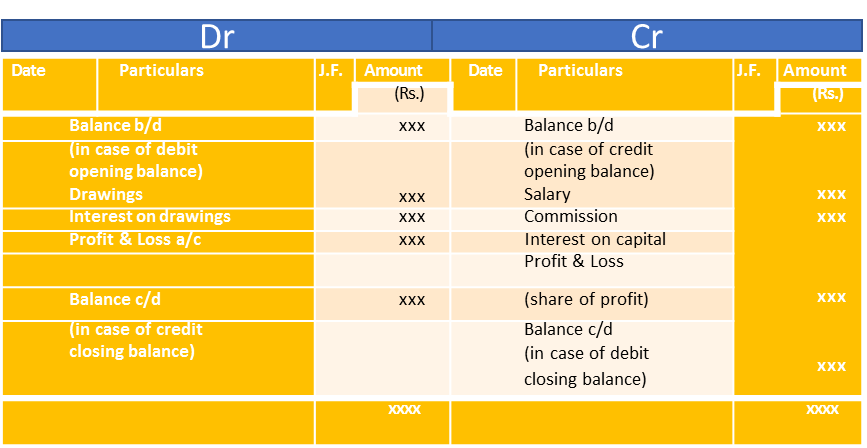
Fig. 2.1: Proforma of Partner’s Capital and Current Account under Fixed Capital Method.
Fluctuating Capital Method: Under the fluctuating capital method, only one account, i.e. capital account is maintained for each partner. All the adjustments such as share of profit and loss, interest on capital, drawings, interest on drawings, salary or commission to partners, etc are recorded directly in the capital accounts of the partners. This makes the balance in the capital account to fluctuate from time to time. That’s the reason why this method is called fluctuating capital method. In the absence of any instruction, the capital account should be prepared by this method. The proforma of capital accounts prepared under the fluctuating capital method is given below:
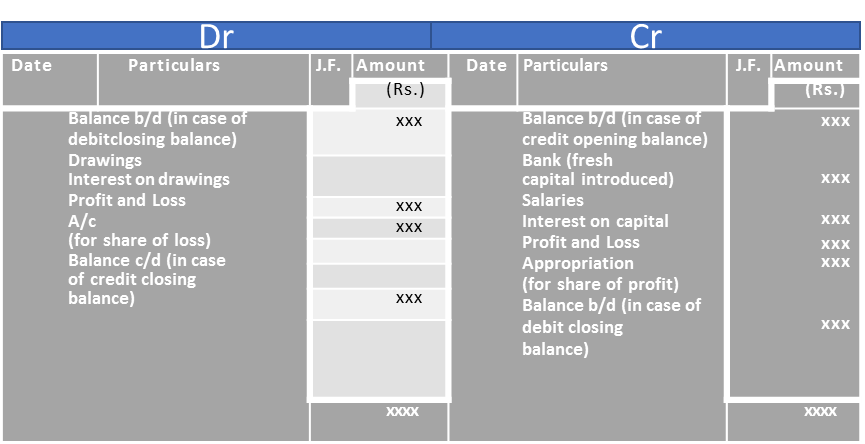
Fig. 2.2: Proforma of Partner’s Capital Account under Fluctuating capital Method.
Distinction between Fixed and Fluctuating Capital Accounts
The main points of differences between the fixed and fluctuating capital methods can be summed up as follows:
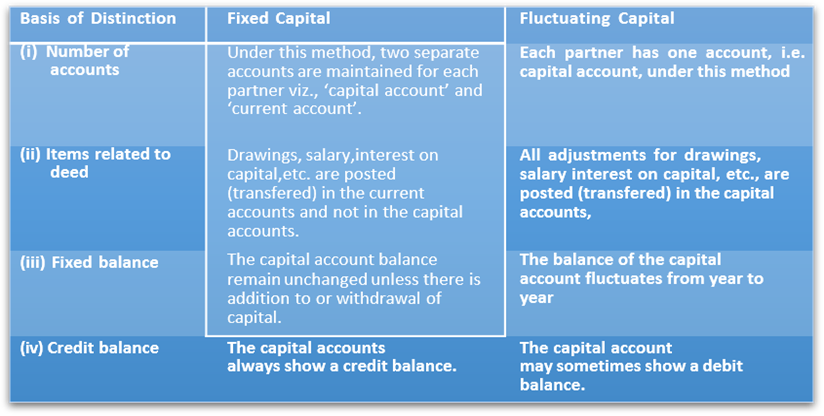
Distribution of Profit among Partners
The profits and losses of the firm are distributed among the partners in an agreed ratio. However, if the partnership deed is silent, the firm’s profits and losses are to be shared equally by all the partners.
You know that in the case of sole partnership the profit or loss, as ascertained by the profit and loss account is transferred to the capital account of the proprietor. In case of partnership, however, certain adjustments such as interest on drawings, interest on capital, salary to partners, and commission to partners are required to be made. For this purpose, it is customary to prepare a Profit and Loss Appropriation Account of the firm and ascertain the final figure of profit and loss to be distributed among the partners, in their profit sharing ratio.
Profit and Loss Appropriation Account
Profit and Loss Appropriation Account is merely an extension of the Profit and Loss Account of the firm. It shows how the profits are appropriated or distributed among the partners. All adjustments in respect of partner’s salary, partner’s commission, interest on capital, interest on drawings, etc. are made through this account. It starts with the net profit/net loss as per Profit and Loss Account. The journal entries for preparation of Profit and Loss Appropriation Account and making various adjustments through it are given as follows:
Journal Entries
1. Transfer of the balance of Profit and Loss Account to Profit and Loss Appropriation Account:
(a) If Profit and Loss Account shows a credit balance (net profit): Profit and Loss A/c Dr.
To Profit and Loss Appropriation A/c
(b) If Profit and Loss Account shows a debit balance (net loss) Profit and Loss Appropriation A/c Dr.
To Profit and Loss A/c
2. Interest on Capital:
(a) For Allowing interest on capital:
Interest on Capital A/c Dr.
To Partner’s Capital/Current A/cs (individually)
(b) For transferring interest on capital to Profit and Loss Appropriation Account: Profit and Loss Appropriation A/c Dr.
To Interest on Capital A/c
3. Interest on Drawings:
(a) For charging interest on drawings to partners’ capital accounts: Partners Capital/Current A/c’s (individually) Dr.
To Interest on Drawings A/c
(b) For transferring interest on drawings to Profit and Loss Appropriation Account: Interest on Drawings A/c Dr.
To Profit and Loss Appropriation A/c
(a) For Allowing partner’s salary to partner’s capital account: Salary to Partner A/c Dr.
To Partner’s Capital/Current A/c’s (individually)
(b) For transferring partner’s salary to Profit and Loss Appropriation Account: Profit and Loss Appropriation A/c Dr.
To Salary to Partner’s A/c
5. Partner’s Commission:
(a) For crediting commission allowed to a partner, to partner’s capital account: Commission to Partner A/c Dr.
To Partner’s Capital/Current A/c’s (individually)
(b) For transferring commission allowed to partners to Profit and Loss Appropriation Account.
Profit and Loss Appropriation A/c Dr.
To Commission to Partners Capital/Current A/c
6. Share of Profit or Loss after appropriations:
(a) If Profit:
Profit and Loss Appropriation A/c Dr.
To Partner’s Capital/Current A/c’s (individually)
(b) If Loss:
Partner’s Capital/Current A/c (individually) To Profit and Loss Appropriation A/c
Note: In case firm suffers a loss, no interest on capital, salary, remuneration is to be allowed to partners. The Proforma of Profit and Loss Appropriation Account is given as follows:
Profit and Loss Appropriation Account
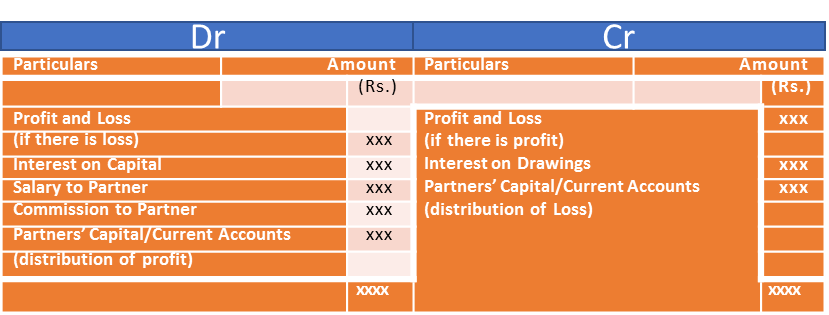
Fig. 2.3: Proforma of Profit and Loss Appropriation Account
Revision 1
Sameer and Yasmin are partners with capitals of Rs.15,00,000 and Rs. 10,00,000 respectively. They agreed to share profits in the ratio of 3:2. Show how the following transactions will be recorded in the capital accounts of the partners in case: (i) the capitals are fixed, and (ii) the capitals are fluctuating. The books are closed on March 31, every year.

Solution
Fixed Capital Method
Partner’s Capital Accounts

Partner’s Current Accounts
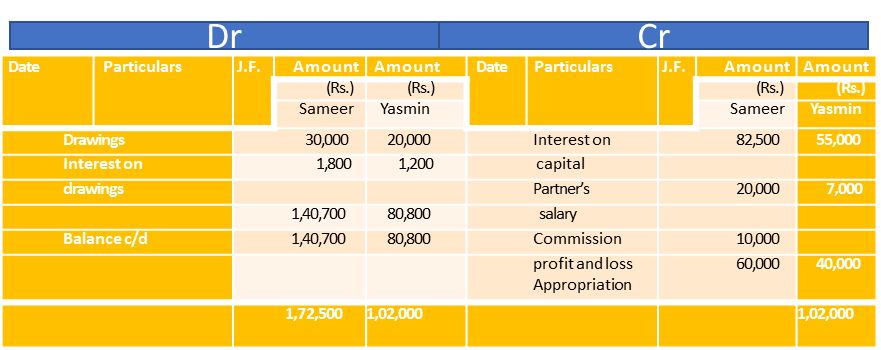
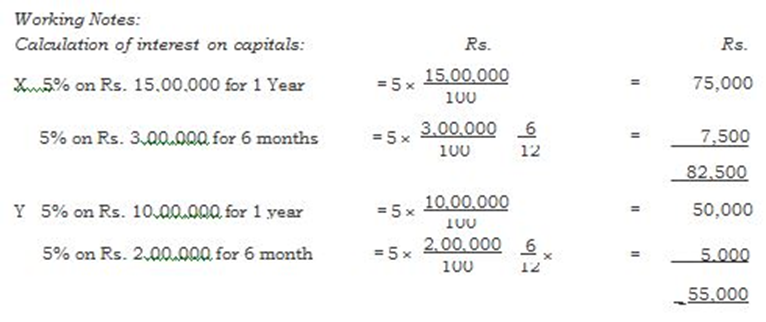
Fluctuating Capital Method
Partner’s Capital Accounts
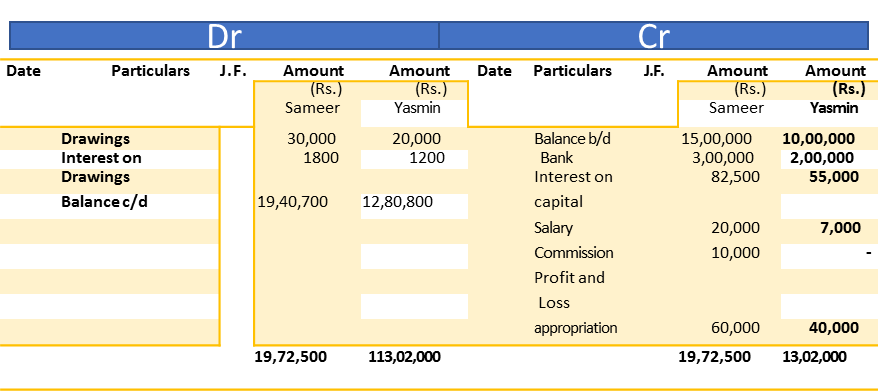
Revision 2
Amit, Babu and Charu set up a partnership firm on April 1, 2019. They contributed Rs. 50,000, Rs. 40,000 and Rs. 30,000, respectively as their capitals and agreed to share profits and losses in the ratio of 3 : 2 :1. Amit is to be paid a salary of Rs. 1,000 per month and Babu, a Commission of Rs. 5,000. It is also provided that interest to be allowed on capital at 6% p.a. The drawings for the year were Amit Rs. 6,000, Babu Rs. 4,000 and Charu Rs. 2,000. Interest on drawings of Rs. 270 was charged on Amit’s drawings, Rs. 180 on Babu’s drawings and Rs. 90, on Charu’s drawings. The net profit as per Profit and Loss Account for the year ending March 31, 2020 was Rs. 35,660. Prepare the Profit and Loss Appropriation Account to show the distribution of profit among the partners.
Solution
Profit and Loss Appropriation Account
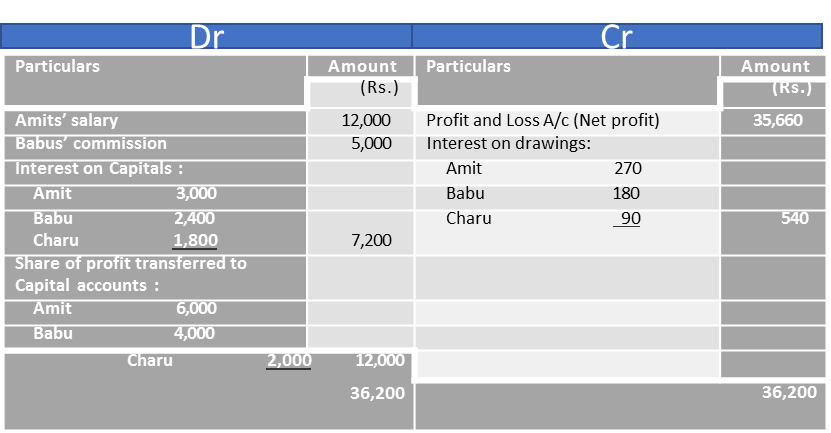
Revision 3
Yadu, Madhu and Vidu are partners sharing profits and losses in the ratio of 2:2:1. There fixed capitals on April 01, 2019 were; Yadu Rs. 5,00,000, Madhu Rs. 4,00,000 and Vidhu Rs. 3,50,000. As per the partnership deed, partners are entitled to interest on capital @ 5% p.a., and Yadu has to be paid a salary of Rs. 2,000 per month while Vidu would be receiving a commission of Rs. 18,000. Net loss of the firm as per profit and loss account for the year ending March 31, 2019 amounted to Rs. 75,000 on the basis of above information prepare profit and loss appropriation account. Prepare profit and loss appropriation account for the year ending March 31, 2019.
Solution
Books of Yadu, Madhu and Vidu Profit and Loss
Appropriation Account for the year ending March 31, 2019

Revision 4
Amitabh and Babul are partners sharing profits in the ratio of 3:2, with capitals of Rs. 50,000 and Rs. 30,000 respectively. Interest on capital is agreed @ 6% p.a. Babul is to be allowed an annual salary of Rs. 2,500. Manager is to be allowed commission Rs. 5,000. Amitabh has also given a Loan on April 01, 2019 of Rs. 50,000 to the firm without any agreement. During the year 2019-20, the profits earned is Rs. 22,250. Prepare Profit and Loss Appropriation account showing the distribution of profit and the partners’ capital accounts for the year ending March 31, 2020.
Solution
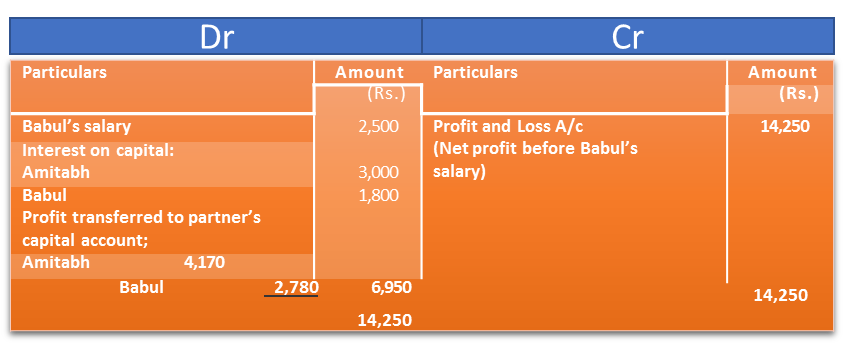
Amitabh’s Capital Account

Babul’s Capital Account
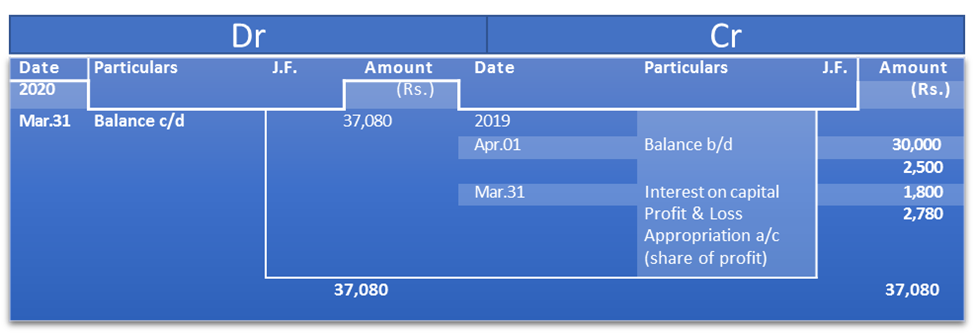
Working Notes:
Profit and Loss Account

Interest on Capital
No interest is allowed on partners’ capitals unless it is expressly agreed among the partners. When the Deed specifically provides for it, interest on capital is credited to the partners at the agreed rate with reference to the time period for which the capital remained in business during a financial year. Interest on capital is generally provided for in two situations: (i) when the partners contribute unequal amounts of capitals but share profits equally, and (ii) where the capital contribution is same but profit sharing is unequal. Interest on capital is calculated with due allowance for any addition or withdrawal of capital during the accounting period. For example, Mohini, Rashmi and Navin entered into partnership, bringing in Rs. 3,00,000, Rs. 2,00,000 and Rs. 1,00,000 respectively into the business. They decided to share profits and losses equally and agreed that interest on capital will be provided to the partners @10 per cent per annum. There was no addition or withdrawal of capital by any partner during the year. The interest on capital works out to Rs. 30,000 (10% on 30,000) for Mohini, Rs. 20,000 (10% on 2,00,000) for Rashmi, and Rs.10,000 (10% on 1,00,000) for Navin.
Take another case of Mansoor and Reshma who are partners in a firm and their capital accounts showed the balance of Rs. 2,00,000 and Rs. 1,50,000 respectively on April 1, 2019. Mansoor introduced additional capital of Rs. 1,00,000 on August 1, 2019 and Reshma brought in further capital of Rs. 1,50,000 on October 1, 2019. Interest is to be allowed @ 6% p.a. on the capitals. It shall be worked as follows:
Rs. 2,00,000 × 6/100 + Rs. 1,00,000 × 6/100 × 8
For Mansoor
= Rs. 12,000 + Rs. 4,000 = Rs. 16,000
For Reshma
= Rs. 1,50,000 × 6/100 + Rs. 1,50,000 × 6/100 × 6/12
= Rs. 9,000+Rs. 4,500= Rs. 13,500
When there are both addition and withdrawal of capital by the partners during a financial year, the interest on capital is calculated as follows:
(i) On the opening balance of the capital accounts of partners, interest is calculated for the whole year;
(ii) On the additional capital brought in by any partner during the year, interest is
calculated from the date of introduction of additional capital to the last day of the financial year.
(iii) In case of withdrawal of capital, interest on capital will be calculated as:
On opening capital from the beginning of the year till date of capital withdrawn and then on the reduced capital for the remaining time period. Alternatively, it can be calculated with respect of amount remained in business for the relevant period.
Revision 5
Saloni and Srishti are partners in a firm. Their capital accounts as on April 01. 2019 showed a balance of Rs. 2,00,000 and Rs. 3,00,000 respectively. On July 01, 2019, Saloni introduced additional capital of Rs. 50,000 and Srishti, Rs. 60,000. On October 01 Saloni withdrew Rs.
30,000, and on January 01, 2020 Srishti withdraw, Rs. 15,000 from their capitals. Interest is allowed @ 8% p.a. Calculate interest payable on capital to both the partners during the financial year 2019–2020.
Solution
Statement Showing Calculation of Interest on Capital :
For Saloni
(Rs.)
Interest on Rs. 2,00,000 for 3 months = Rs.2, 00, 000 × 8 × 3/100 × 12 = 4,000
Add : Interest on Rs. 2,50,000 for 3 months = Rs.2, 50, 000 × 8 × 3/100 × 12 = 5, 000
Add : Interest on Rs. 2,20,000 for 6 months = Rs.2, 20, 000 × 6/12 × 8/100 = 8,800
Total - 17,800
For Srishti
(Rs.)
Interest on Rs. 3,00,000 for 3 months = Rs.3, 00, 000 × 3/12 × 8/100 = 6,000
Add : Interest on Rs. 3,60,000 for 6 months = Rs.3, 60, 000 × 8/100 × 6/12 = 14, 400
Add : Interest on Rs. 2,20,000 for 3 months = Rs.3, 45, 000 × 8/100 × 3/12 = 300
Sometimes opening capitals of partners may not be given. In such a situation before calculation of interest on capital the opening capitals will have to be worked out with the help of partners’ closing capitals by marking necessary adjustments for the additions and withdrawal of capital, drawings, share of profit or loss, if already shown in the capital accounts the partners.
Revision 6
Josh and Krish are partners sharing profits and losses in the ratio of 3:1. Their capitals at the end of the financial year 2015-2016 were Rs. 1,50,000 and Rs. 75,000. During the year 2015-2016, Josh’s drawings were Rs. 20,000 and the drawings of Krish were Rs. 5,000, which had been duly debited to partner’s capital accounts. Profit before charging interest on capital for the year was Rs. 16,000. The same had also been debited in their profit sharing ratio. Krish had brought additional capital of Rs. 16,000 on October 1, 2015. Calculate interest on capital @ 12% p.a. for the year 2015-2016.
Solution
Statement Showing Calculation of Capital at the Beginning
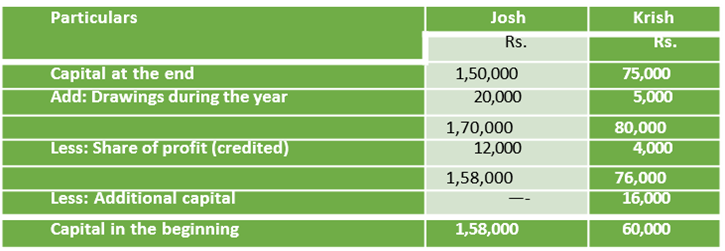
Interest on capital will be as 18,960 (12% of Rs. 1,58,000) for Josh and Rs. 960 for krish calculated as follows:
(Rs. 60,000 × 12/ 100) + ( Rs. 16,000 × 12/100 × 6/12) = Rs. 7,200 + Rs. 960 = Rs. 8,160.
As clarified earlier, the interest on capital is allowed only when the firm has earned profit during the accounting year. Hence, no interest will be allowed during the year the firm has incurred net loss and if in a year, the profit of the firm is less than the amount due to the partners as interest on capital, the payment of interest will be restricted to the amount of profits. In that case, the profit will be effectively distributed in the ratio of interest on capital of each partner.
Revision 7
Anupam and Abhishek are partners sharing profits and losses in the ratio of 3 : 2. Their capital accounts showed balances of Rs. 1,50,000 and Rs. 2,00,000 respectively on April 01, 2019. Show the calculation of interest on capital for the year ending December 31, 2020 in each of the following alternatives:
(a) If the partnership deed is silent as to the payment of interest on capital and the profit for the year is Rs. 50,000;
(b) If partnership deed provides for interest on capital @ 8% p.a. and the
firm incurred a loss of Rs. 10,000 during the year;
(c) If partnership deed provides for interest on capital @ 8% p.a. and the firm earned a profit of Rs. 50,000 during the year;
(d) If the partnership deed provides for interest on capital @ 8% p.a. and the firm earned a profit of Rs. 14,000 during the year.
Solution
(a) In the absence of a specific provision in the Deed, no interest will be paid on the capital to the partners. The whole amount of profit will however be distributed among the partners in their profit sharing ratio.
(b) As the firm has incurred losses during the accounting year, no interest on capital
will be allowed to any partner. The firm’s loss will however be shared by the partners in their profit sharing ratio.
Rs.
(c) Interest to Anupam @ 8% on Rs. 1,50,000 = 12,000
Interest to Abhishek @ 8% on Rs. 2,00,000 = 16,000
= 28,000
As the profit is sufficient to pay interest at agreed rate, the whole amount of interest on capital shall be allowed and the remaining profit amounting to Rs. 22,000 (Rs. 50,000 – Rs. 28,000) shall be shared by the partners in their profit sharing ratio.
(d) As the profit for the year is Rs. 14,000, which is less than the amount of interest on capital due to partners, i.e. Rs. 28,000 (Rs. 12,000 for Anupam and Rs. 16,000 for Abhishek), interest will be paid to the extent of available profit i.e., Rs. 14,000. Anupam and Abhishek will be credited with Rs. 6,000 and Rs. 8,000, respectively. Effectively this amounts to sharing the firm’s profit in the ratio of interest on capital, i.e., 3:4.
Interest on Drawings
The partnership agreement may also provide for charging of interest on money withdrawn out of the firm by the partners for their personal use. As stated earlier, no interest is charged on the drawings if there is no express agreement among the partners about it. However if the partnership deed so provides for it, the interest is charged at an agreed rate, for the period for which drawings have been made. Remained outstanding from the partners during an accounting year. Charging interest on drawings discourages excessive amounts of drawings by the partners. The calculation of interest on drawings under different situations is shown as here under.
When Fixed Amounts was Withdrawn Every Month
Many a time, a fixed amount of money is withdrawn by the partners, at equal time interval, say each month or each quarter. While calculating the time period, attention must be paid to whether the fixed amount was withdrawn at the beginning (first day) of the month, middle of the month or at the end (last day) of the month. If withdrawn on the first day of every month, interest on total amount will be calculated for 6½ months; if withdrawn at the end at every month, it will be calculated for 5½ months, and if withdrawn during the middle of the month, it will be calculated for 6 months.
Suppose, Aashish withdrew Rs. 10,000 per month from the firm for his personal use during the year ending March 31, 2017. The calculation of average period and the interest on drawings, in different situations would be as follows:
(a) When the amount is withdrawn at the beginning of each month:

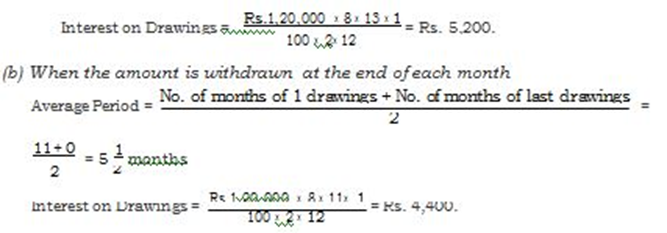
(c) When money is withdrawn in the middle of the month
When money is withdrawn in the middle of the month, nothing is added or deduced from the total period.

When Fixed Amount is withdrawn Quarterly
Suppose Satish and Tilak are partners in a firm, sharing profits and losses equally. During financial year 2016–2017, Satish withdrew Rs. 30,000 quarterly. If interest is to be charged on drawings @ 8% per annum, the calculation of average period and interest on drawings will be as follows:
(a) If the amount is withdrawn at the beginning of each quarter
Statement Showing Calculation of Interest on Drawings
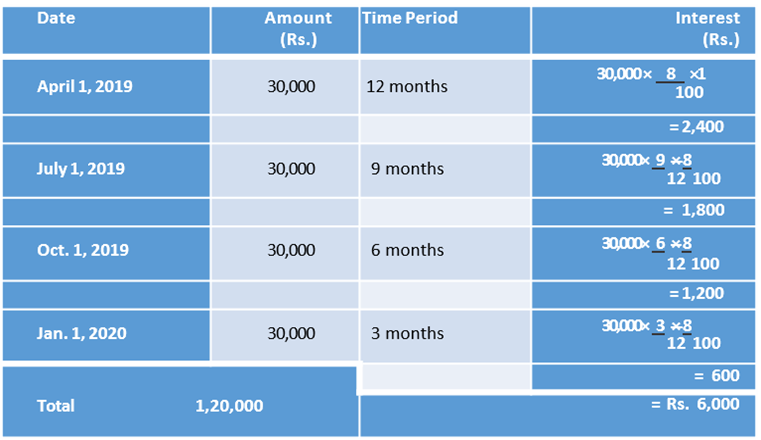
Rs. 1,20,000 × 8/100 × 15/2 × 1/12 = Rs 6, 000
(b) If the amount is withdrawn at the end of each quarter
Statement Showing Calculation of Interest on Drawings
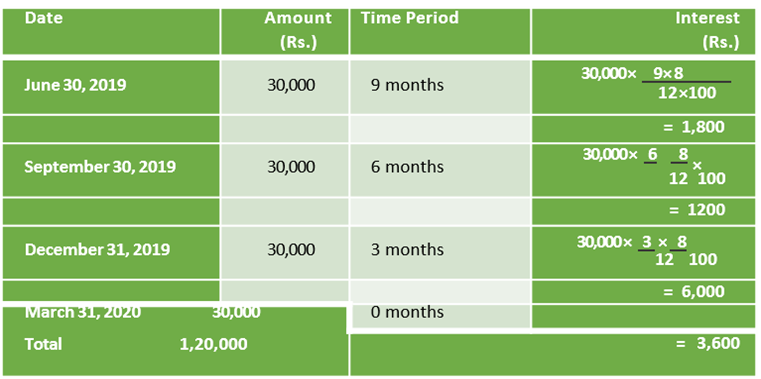
Alternatively, the interest can be calculated on the total amount withdrawn during the accounting year, i.e., Rs. 1,20,000 for a period of 4½ months
(9 + 6 + 3 + 0)/4 months as follows: = Rs. 1,20,000 × 8/100 × 9/2 × 1/12 = 3, 600.
When Varying Amounts are Withdrawn at Different Intervals
When the partners withdraw different amounts of money at different time intervals, the interest is calculated using the product method. Under the product method, for each withdrawal, the money withdrawn is multiplied by the period (usually expressed in months) for which it remained withdrawn during the financial year. The period is calculated from the date of the withdrawal to the last day of the accounting year. The products so calculated are totalled on the total of the products interest at the specified rate is calculated as under:
Total of products × Rate × 1/12
For example, Shahnaz withdrew the following amounts from her firm, for personal use during the year ending March 31, 2017. Calculate interest on drawings by product method, if the rate of interest to be charged is 7 per cent per annum

Calculation of interest on drawings will be as follows:

Interest = Sum of Products × Rate × 1/12 = 4, 50, 000 × 7/100 × 1/12 = 30100/12 = Rs 2, 508 (approx).
Revision 8
John Ibrahm, a partner in Modern Tours and Travels withdrew money during the year ending March 31, 2020 from his capital account, for his personal use. Calculate interest in drawings in each of the following alternative situations, if rate of interest is 9 per cent per annum.
(a) If he withdrew Rs. 3,000 per month at the beginning of the month.
(b) If an amount of Rs. 3,000 per month was withdrawn by him at the end of each month.
(c) If the amounts withdrawn were : Rs. 12,000 on June 01, 2019, Rs. 8,000; on August 31, 2019, Rs. 3,000; on September 30, 2019, Rs. 7,000, on November 30, 2019, and Rs. 6,000 on January 31, 2020.
Solution
(a) As a fixed amount of Rs. 3,000 per month is withdrawn at the beginning of the month, interest on drawings will be calculated for an average period of
(b) As the fixed amount of Rs. 3,000 per month is withdrawn at the end of each month, interest on drawings will be calculated for an average period of
= Rs.36,000 ×9 ×11×1 = Rs. 1,485
100×2×12
(c) Statements showing Calculation of Interest on Drawings
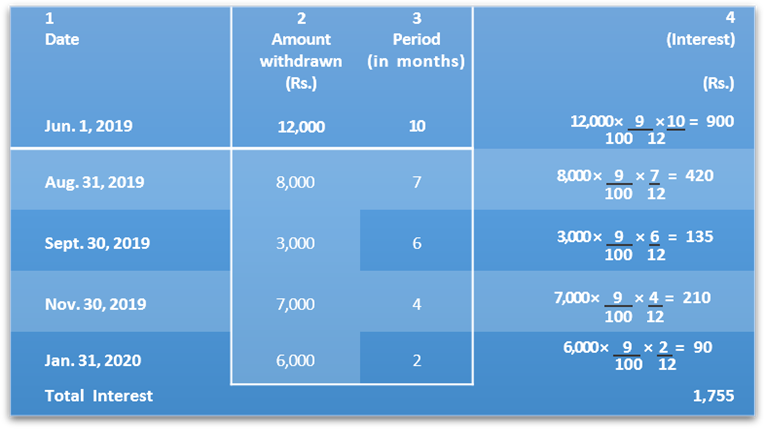
Revision 9
Manu, Harry and Ali are partners in a firm sharing profits and losses equally. Harry and Ali withdrew the following amounts from the firm, for their personal use during 2019-2020.

Calculate interest on drawings if the rate of interest to be charged is 10 per cent, and the books are closed on December 31 every year.
Statement Showing Calculation of Interest on Drawings

Amount of Interest
Mannu = Rs 1,56,000 x 10 x 1/100 x 12 = Rs 1, 300
Ali = Rs 1, 50, 000 x 10 x 1/ 100 x 12 = Rs 1, 250
When Dates of Withdrawal are not specified
Rs 60, 000 x 8 x 6/100 x 12 = Rs 2, 400
Rs 60, 000 × 8 × 6/100 × 12 = Rs 2, 400
MAINTENANCE OF CAPITAL ACCOUNTS& DISTRIBUTION OF PROFITS AMONG THE PARTNERS
To record the changes in Capital A/c of each partner, we prepare individual capital accounts for each partner. The capital accounts of partners can be maintained in two methods :
Fixed Capital Method
Fluctuating Capital Method
- Fixed Capital Method – In this method, the capital A/c of partners remains unaltered or fixed. When this method is followed, two accounts i.e. Capital A/c & Current A/c for each partner are maintained.
- Capital A/c – The capital account remains unaltered i.e. fixed unless additional capital is introduced or withdrawal is made from the existing capital. If there is no fresh capital introduced or any withdrawals, the capital account of the partner show the same balance year after year.
- Current A/c – It is prepared to record transactions other than introduction & withdrawal of capital such as interest on capital, interest on drawings, salary or commission to a partner, and share of profits/losses. The balance of current account always keeps fluctuating because of these adjustments.
Current A/c is debited with;
- Drawings made by partner
- Interest on drawings
- Share of loss
- Transfer of amount to any capital account permanently
Current A/c is credited with;
- Interest on capital
- Salary or commission
- Share of profits
- Transfer of any amount from capital account permanently

- Fluctuating Capital A/c – Under Fluctuating Capital method, only one account namely Capital A/c is maintained for each partner. All the transactions of a partner like salary, commissions, interest on capital are recorded in this account. As a result of this, the capital a/c fluctuates with every transaction. The debit balance of capital account is shown in the liabilities side & the credit balance is shown in the asset side.

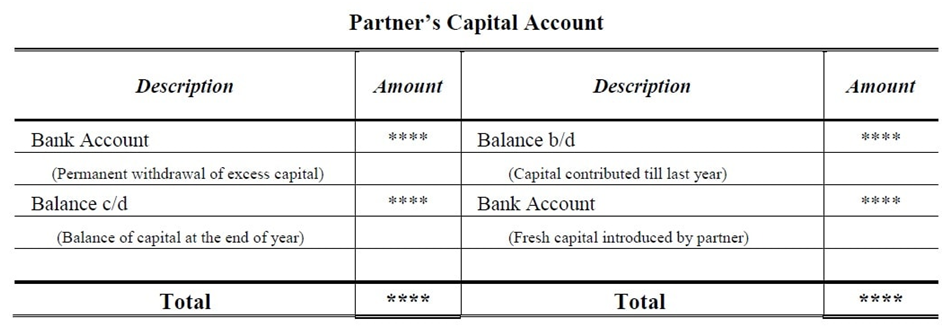


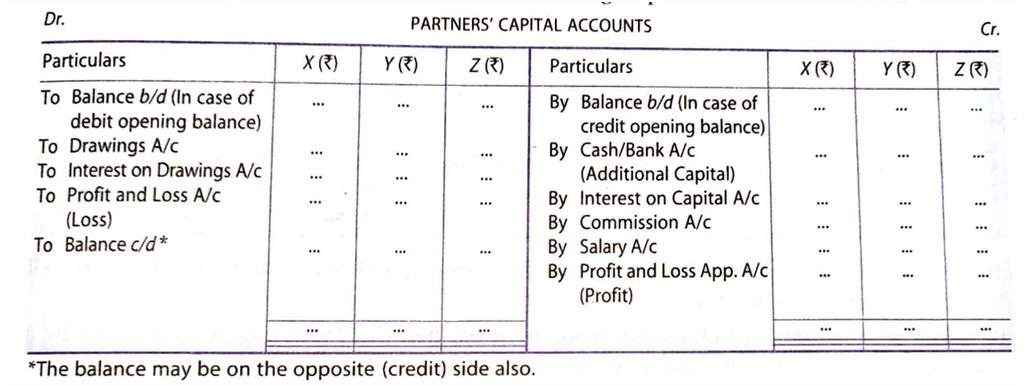
INTEREST ON DRAWNGS
- Drawings refers to the amount withdrawn by the owner in cash or in kind.
- Interest on drawings is charged only when it is mentioned in the partnership deed.
- When it is charged, it is debited to Profit & Loss Appropriation A/c.
- It is either debited to Partner’s Capital A/c or Current A/c depending on whether Fixed Capital or Fluctuating Capital method is being followed
INTEREST ON DRAWINGS : - HOW IT IS CALCULATED?
- The computation of Interest on Drawings depends upon various factors like when the amount is withdrawn & the time period for which it remains withdrawn etc.
- So, the situations can be as follows;
- Fixed amount is withdrawn at the BEGINNING of every Month
If a partner withdraws fixed amount in the beginning of every month, interest is charged on the whole amount for 6 ½ months
Interest on Drawings = Total Drawings X Rate of Interest X 6 ½ 100 12
6 ½ months = Average Period
Average Period Formula = Time left after first drawings + Time left after last drawings 2
- Average period should be used only when the amount of Drawings is uniform & the time interval between the two consecutive drawings is also uniform.
- Fixed amount is withdrawn at the END of every Month.
If a partner withdraws a fixed amount at the end of every month, interest is charged for 5 ½ months.
Interest on Drawings = Total Drawings X Rate of Interest X 5 ½ 100 12
- Fixed amount is withdrawn in the MIDDLE of every Month
Interest on Drawings = Total Drawings X Rate of Interest X 6 100 12
- Fixed amount is withdrawn at the BEGINNING of every QUARTER
Interest on Drawings = Total Drawings X Rate of Interest X 7 ½ 100 12
- Fixed amount is withdrawn in the MIDDLE of every QUARTER
Interest on Drawings = Total Drawings X Rate of Interest X 6 100 12
- Fixed amount is withdrawn at the END of every QUARTER
Interest on Drawings = Total Drawings X Rate of Interest X 4 ½ 100 12
- Fixed amount is withdrawn during 6 MONTHS
- At the BEGINNING OF EACH MONTH
Interest on Drawings = Total Drawings X Rate X 3 ½
100 12
- In the MIDDLE OF EACH MONTH
Interest on Drawings = Total Drawings X Rate X 3
100 12
- At the END OF EACH MONTH
Interest on Drawings = Total Drawings X Rate X 3 ½
100 12
- If Unequal amount is withdrawn at DIFFERENT DATES, interest on drawings is calculated on the basis of the Simple Method or Product Method
Interest on Drawings = Total of Product X Rate of Interest x 1 or 1 100 12 365
- When the date of withdrawal IS NOT GIVEN, the interest on drawings is calculated for six months on an average basis.
- When Rate of Interest is given without the word PER ANNUM, interest is charged without considering the time factor
Journal Entries to Record Interest on Drawings
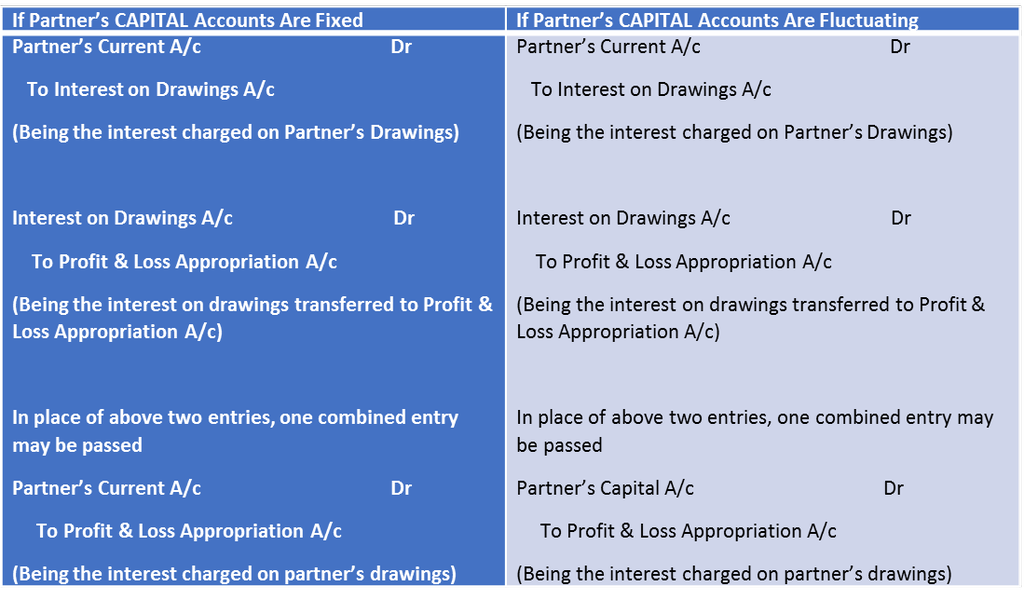
Salary or Commission to Partners
- Salary or commission to partners is paid only when it is allowed in Partnership Deed
- It is an appropriation of profit & not charge against the profit so it should be allowed only when profit is earned
- Commission may be allowed to the partners either
- As a percentage of profit before charging such commission
Net Profit (before Commission) x Rate of commission
100
or
- As a percentage of profit after charging such commission
Net profit (before commission) x Rate of Commission
100+Rate of Commission
Accounting Treatment:-
Partner’s Salaries/ Commission A/c Dr
To Partner’s Current A/c (When capitals are fixed)
To Partner’s Capital A/c (When capitals are fluctuating)
Profit & Loss Appropriation A/c Dr
To Partner’s salaries/commission A/c
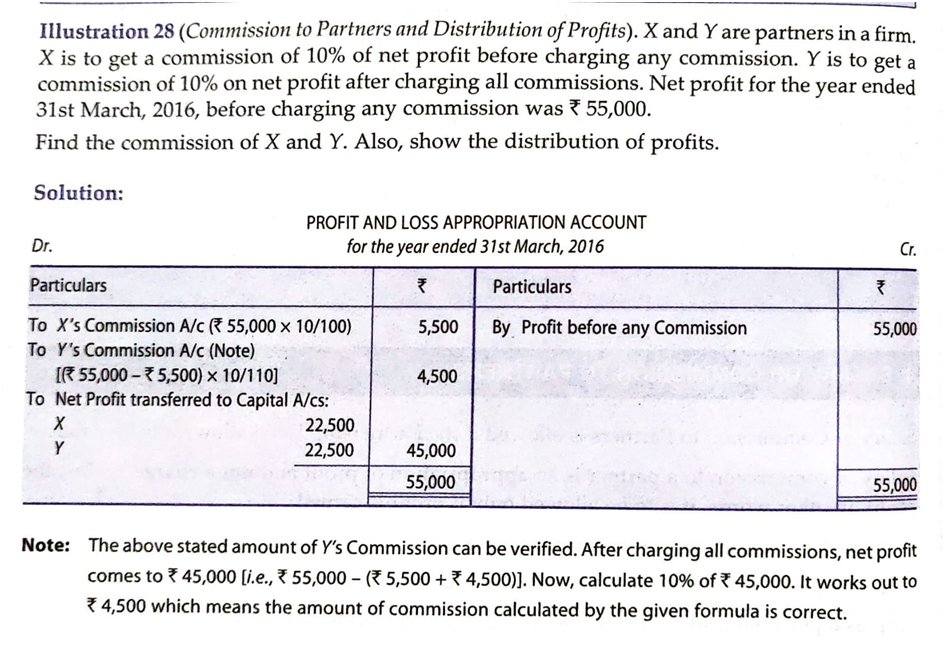
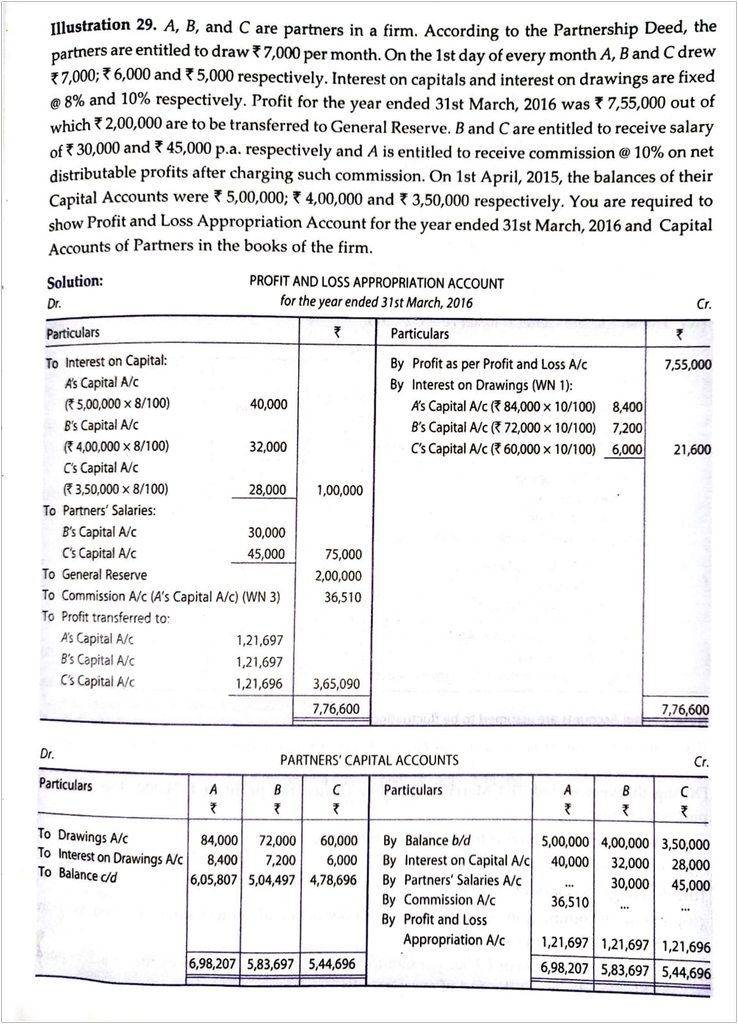
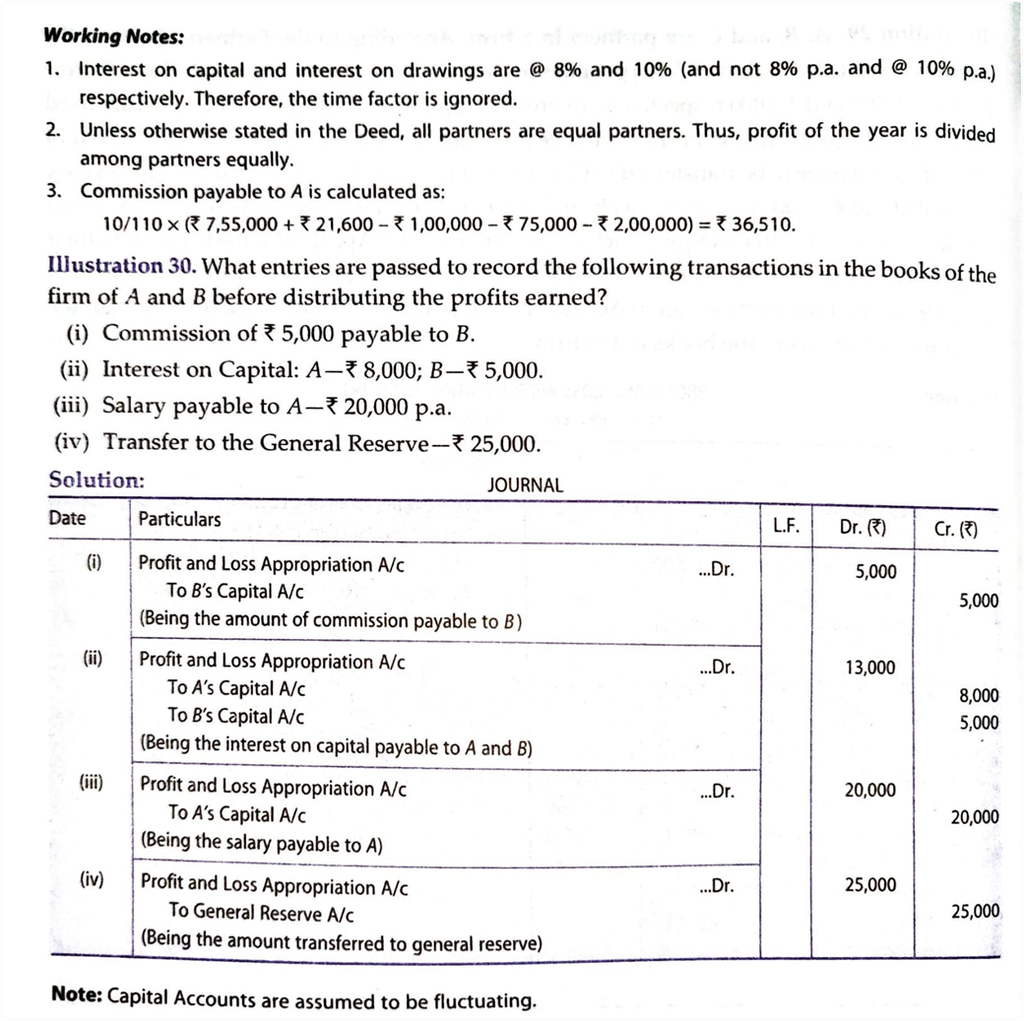
Interest on Partner’s Loan to the Firm
- If a partner apart from investing share capital, advances any loan to the firm then he is entitled to receive interest even in the absence of an agreement/deed.
- In the absence of an agreement/deed, the minimum rate of interest on loan to be paid to the partner is 6% p.a.
- Interest on loan is a charge against profit & it is transferred to the debit of Profit/Loss A/c & not to the debit of Profit/Loss Appropriation A/c
- Journal Entries
- Interest on partner’s loan A/c Dr
To Partner’s Loan A/c
- Profit & Loss A/c Dr
To Interest on partner’s loan A/c

 Vision classes
Vision classes
